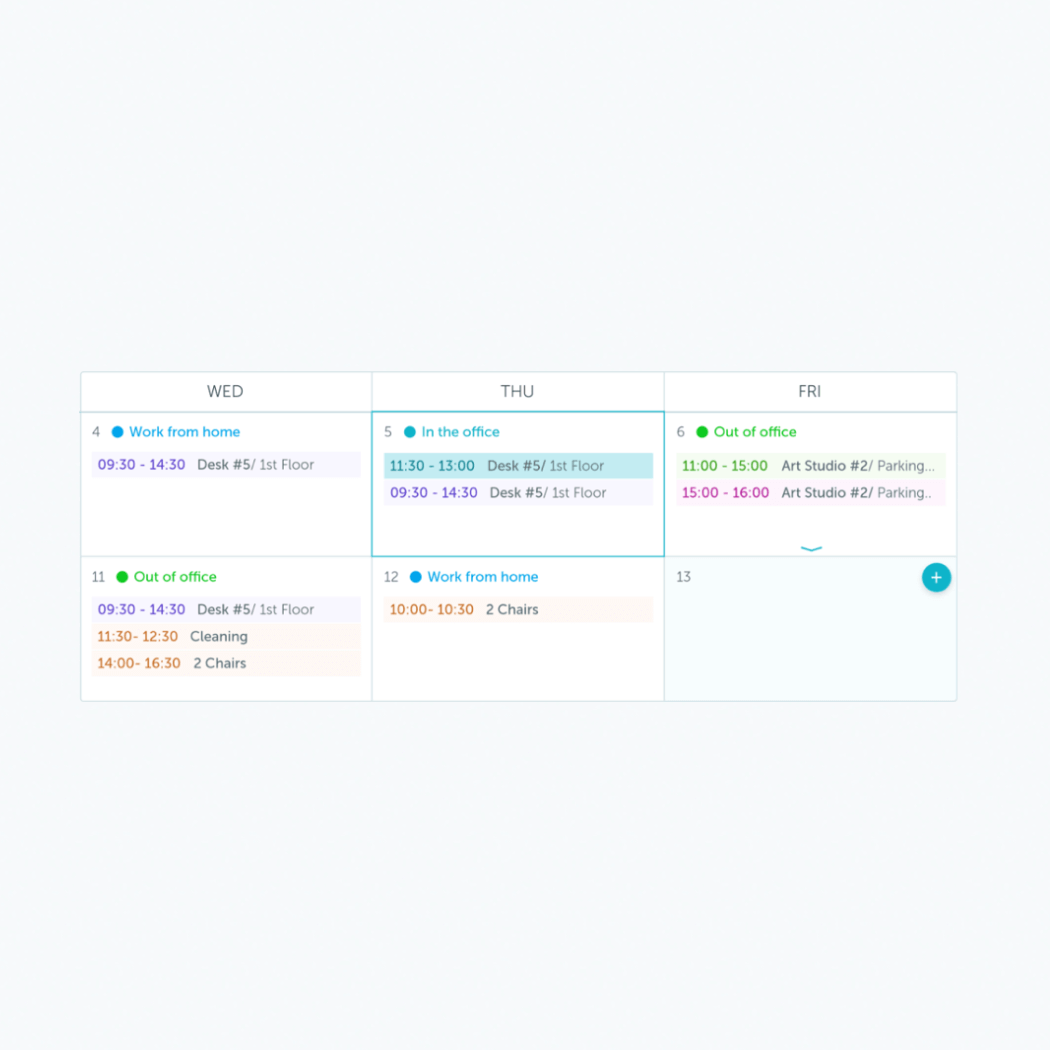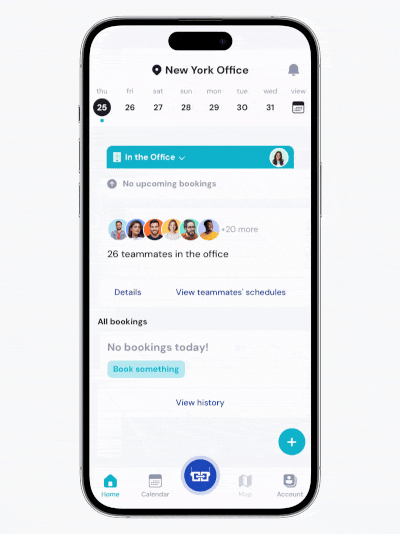






Of employees prefer hybrid work model
(mix of office work and remote work).
Of employers plan to offer some kind of
hybrid work schedule in the coming future.
Of high-growth companies use
“productivity anywhere” hybrid models.
How do you create a hybrid work schedule?
With Yarooms, every employee can autonomously create a hybrid work schedule that maximizes productivity while supporting a healthy work-life balance.
Open the hybrid work planner
Access the Yarooms hybrid work planning calendar to organize your hybrid work schedule easily.
Set your hybrid work schedule
Choose your remote work and office work days for a day, week, or month, ensuring a smooth balance between personal flexibility and team needs.
Book office spaces for collaboration
Reserve your workspace for in-office days, and check who will be there to plan face-to-face collaborations and meetings.
All hybrid work schedules in one calendar
Yarooms work planning calendar is an intuitive hybrid scheduling tool designed to support flexibility and collaboration within your organization.
✔ Allow employees the autonomy to manage their hybrid schedules, office space, and resources
✔ Set work-from-home thresholds
✔ Align hybrid schedules with available office space
✔ Ensure full planning visibility for all employees
All hybrid work schedules in one calendar
Yarooms work planning calendar is an intuitive hybrid scheduling tool designed to support flexibility and collaboration within your organization.
✔ Allow employees the autonomy to manage their hybrid schedules, office space, and resources
✔ Set work-from-home thresholds
✔ Align hybrid schedules with available office space
✔ Ensure full planning visibility for all employees
%20(1).png?width=2000&name=calendar%20view-work%20statuses%20(1)%20(1).png)
%20(1).png?width=2000&name=calendar%20view-work%20statuses%20(1)%20(1).png)

Full flexibility and autonomy
Create your hybrid work schedule for the day, week, or another time interval.

Your own hybrid work schedule
Define your own hybrid work schedule: set up a ratio between working remotely and days in the office.

User-friendly mobile application
Create your hybrid schedule and book spaces for days at the office on the go.

Better work schedule visibility
Maintain hybrid schedule visibility across your organization to support smooth collaboration.
Success story: Saipem’s hybrid workplace
![]()
After moving to a new office, Saipem adopted a hybrid work model, and Yarooms provided the software to help them manage hybrid work schedules smoothly.
Success story: Saipem’s hybrid workplace
![]()
After moving to a new office, Saipem adopted a hybrid work model, and Yarooms provided the software to help them manage hybrid work schedules smoothly.


Insights to get you started
Creating the perfect hybrid work schedule is no small feat.
We collected a couple of insightful resources to help you navigate the sea of information. Continue your research:
Ready to see the big picture?
Learn how thousands of forward-thinking organizations use YAROOMS to manage
their hybrid work schedules. Join us for a Live Demo or watch the On-demand Platform Tour.
their hybrid work schedules. Join us for a Live Demo or watch the On-demand Platform Tour.
Hybrid work schedule: FAQ
Answering the most popular questions about hybrid and remote work schedulling.
What is a hybrid work schedule?
What are the different types of hybrid work schedules?
There are several types of hybrid work schedules that can be tailored to meet the needs of the workforce and employers. Each offers varying levels of flexibility and can be customized based on the nature of the tasks and collaboration required. Here are the most common types:
- Fixed Hybrid Schedule: In this model, workers have set days when they either work from home or in the office. For example, an employee might be in the office on Mondays and Wednesdays and work remotely the other days. This employee scheduling approach offers predictability while still maintaining some shift flexibility.
- Flexible Hybrid Schedule: This model allows employees to choose when they want to work from home and when they want to be in the office. It offers more freedom and flexible employee scheduling, giving workers the ability to decide their own working hours and shifts based on their preferences and team-driven needs. It's ideal for best hybrid approaches where autonomy is important.
- Shift-Based Hybrid Schedule: In this model, employees alternate between working in the office and remotely. It can be based on weekly or even daily shifts, depending on the specific tasks or the availability of office space. This employee scheduling is particularly useful for roles where working hours in the office are required for certain periods but not full-time.
- Task-Based Hybrid Schedule: Employees come and use the office space for specific tasks such as meetings with team members or project collaborations. Once these are completed, they can return to remote work. This allows for a dynamic work environment and is highly adaptable, making it a flexible model for employers to implement.
- Office-First Hybrid Schedule: In this model, employees are primarily based in the office but can occasionally work from home as needed. This is more office-centric, with workers expected to be physically present during working hours unless special situations arise.
How many days a week is hybrid work?
In a hybrid schedule, the number of days an employee spends between remote work and office time can vary depending on the company's policies and the employee's role. A common arrangement is splitting the week, where employees work remotely for three days and spend two days in the office. This type of split allows for a balance between in-person collaboration and independent tasks.
The flexibility of the hybrid work schedule reduces the need for daily commuting, giving employees more control over their time and improving work-life balance. Some organizations may offer different splits, such as four days remote and one day in the office, depending on their needs and how much office presence is required.
In essence, any arrangement that combines remote work and in-office work qualifies as a hybrid work schedule. Some setups may be predominantly office-based, with only occasional remote work, while others might be largely remote with minimal office time. Regardless of the specific split, as long as there is a combination of both remote and in-office work, it's considered a hybrid model.
How do I make a hybrid work schedule?
To create a successful hybrid work schedule, start by assessing the needs of both employers and employees. Consider the nature of the tasks and roles to determine how much face time in the office is necessary versus how much can be done remotely. You should also look at the team schedule to ensure that important collaborative work between team members aligns with in-office days.
When you implement the schedule, establish clear expectations for working hours and how the shift between remote and in-office work will occur. The key is to create a flexible schedule that accommodates both the business's goals and the workers' preferences.
The best hybrid work schedule will allow you to empower employees by giving them some autonomy to choose where and when they work most effectively while still ensuring that there is enough in-person interaction to maintain productivity and team cohesion. Striking this balance will result in a hybrid work schedule that maximizes both flexibility and efficiency for all parties involved.
What is a 3 2 2 hybrid schedule?
A 3-2-2 hybrid schedule is a type of hybrid work model in which employees spend three days working in the office, two days engaging in remote work or working from home, and two days enjoying two days off. This schedule offers a blend of office collaboration with team members and independent work, providing flexibility to the workforce.
A 3-2-2 hybrid schedule aims to enhance work-life balance while maintaining team cohesion and productivity. It allows team members to engage with each other in-person during their office days, while still giving remote workers time to focus on tasks from home. By providing this balance between office and home-based work, the hybrid work model improves overall employee satisfaction and accommodates different working preferences across the team.
Is hybrid work schedule worth it?
Yes, a hybrid work schedule can be highly beneficial for both employees and employers. Allowing employees to work remotely part of the time offers the flexibility needed to create a better work-life balance. This flexible work arrangement reduces the strain of daily commuting and allows employees to manage their personal lives more effectively, leading to higher employee satisfaction.
A hybrid workplace also promotes autonomy, as employees have more control over their work environment and how they organize their time. This flexibility can lead to increased productivity, as employees can choose the workspace that best helps them focus. Additionally, time spent in the office encourages collaboration and helps maintain strong relationships with team members.
The hybrid work schedule balances remote work and in-office days, fostering employee engagement by providing varied experiences. Ultimately, a well-designed hybrid work schedule creates a supportive environment that combines the best of both worlds, contributing to a positive and productive work environment.
Is hybrid working the same as remote working?
No, hybrid working is not the same as remote working, though both involve working remotely. In a hybrid work model, employees split their time between working from a workplace (typically an office space) and working remotely. For instance, in a typical hybrid model, employees might spend three days working remotely and two days in the office. Among other benefits, this setup reduces commuting while allowing in-person collaboration, such as brainstorming sessions.
In contrast, remote work means that employees perform all of their tasks outside the office, with no requirement to enter the workplace. This setup can be fully independent of location and does not involve any scheduled in-office time or physical meetings with team members.
While both models offer flexibility, the hybrid work model provides a mix of in-office and remote environments, potentially boosting employee satisfaction by allowing for both autonomy and direct collaboration. Remote employees, on the other hand, work entirely from outside the traditional workplace and often even have flexible working hours.
How do you maximize hybrid working?
To maximize hybrid working, it's essential to effectively combine remote work and in-office activities, ensuring that the hybrid model works for all employees. Here are key strategies:
- Implement flexible work arrangements: Offer flexible schedules that allow employees to alternate between remote working and using office space based on their tasks and the company's needs. This helps optimize work-life balance and boosts employee engagement.
- Leverage the flexibility of the hybrid model: Adjust working hours to meet the needs of different types of hybrid workers, whether they prefer to work from home more often or spend time in the office. This allows remote workers and in-office employees to collaborate effectively despite differences in location.
- Create a balanced work environment: Ensure the in-office time focuses on collaboration and team-driven activities like brainstorming. At the same time, remote employees are empowered to focus on deep, independent work. This balance between face time and independent work can significantly improve productivity and employee satisfaction.
- Minimize commuting and enhance work-life balance: The hybrid model can improve overall job satisfaction and boost performance across the workforce by reducing the frequency of commuting for remote employees and offering flexible work options.
- Empower employees and boost engagement: Work with employees to implement the best hybrid schedule, giving them the autonomy to choose working hours and working locations. This will empower them to be productive and more engaged with the team members.
Employers can effectively implement and maximize the benefits of hybrid model by focusing on flexibility, optimizing office space, and creating an inclusive work environment.
















